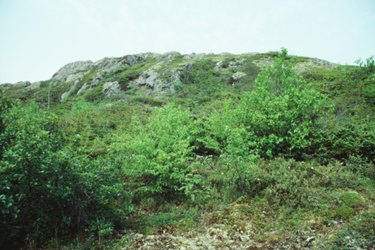
Plants that have deep, extensive root systems can successfully grow on hillsides. Deep roots help to prevent erosion by stabilizing the soil. Some plants produce a large central root called the taproot. Others have a fibrous root system which lacks a taproot. For easier watering, the University of California Sonoma County Master Gardeners recommends a drip irrigation system for hillside plants. Place plants that tolerate soaked soil near the bottom of the hill.
Trees
Video of the Day
Some trees have deep, extensive root systems that anchor them to hillsides. The northern black cottonwood is a deciduous tree that grows up to 100 feet high and 40 feet wide. Its fibrous root system is deep and extensive. This large tree thrives in full sun and moist soil and will tolerate light flooding. Other deep-rooted trees include red alder, which grows well in poor soil, and the multi-stemmed Pacific willow, which establishes and grows quickly in saturated soil.
Video of the Day
Shrubs
Serviceberry is a deep-rooted deciduous shrub or small tree that grows best in well-drained, slightly acidic, moist soil. Its height ranges from 3 to 30 feet and it produces white flowers and purple berries. Serviceberry grows naturally on sunny slopes or partially shaded areas. Other deep-rooted shrubs that grow well on hillsides include cascara and Hooker willow. According to the Washington State Department of Ecology, cascara produces black berries which attract birds, and Hooker willow resists disease and tolerates salt.
Groundcovers
Groundcovers with extensive, deep root systems, such as bugleweed and wintercreeper, grow well on steep slopes. Bugleweed thrives in well-drained soil in a sunny area but will tolerate shade. It grows up to 4 inches tall and produces dark green leaves and blue flower clusters. Its runners produce an extensive root system that helps to prevent hillside erosion. Wintercreeper grows up to 8 to 12 inches tall and produces evergreen leaves. Its runners develop deep roots that stabilize soil. The University of Missouri Extension states that these groundcovers can become invasive and should not grow near natural vegetation.
Vetiver Grass
Vetiver grass has received attention for its ability to stabilize hillsides and prevent erosion. In July 2006, the Louisiana State University Agriculture Center released a report citing vetiver as a stabilizer for earthen levees along the Gulf of Mexico coast. This grass tolerates most soil types and produces deep, widespread roots that anchor it to hillsides and slopes. Vetiver grass also repels termites, which interfere with erosion control when they feed on hillside trees.
- University of California Sonoma County Master Gardeners: Gardening on a Hillside
- Washington State Department of Ecology: Slope Stabilization – Plant Selection Guide
- University of Missouri Extension: Selected Groundcovers for Missouri; Christopher J. Starbuck; August 2007
- Montana State University Extension Service: Serviceberry; S. Smoliak et al.